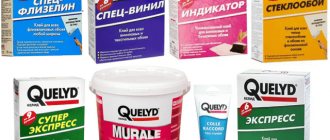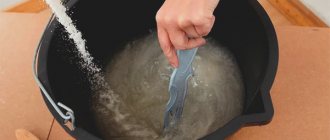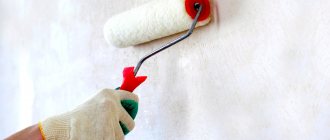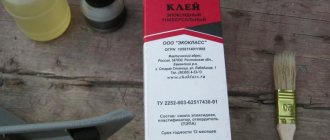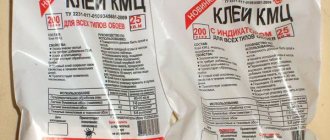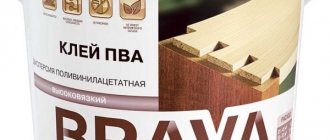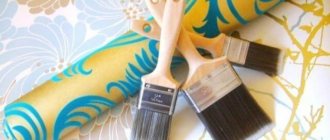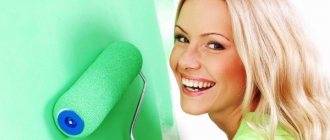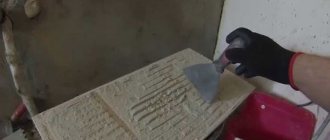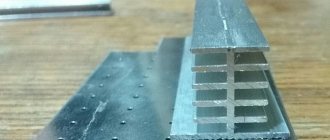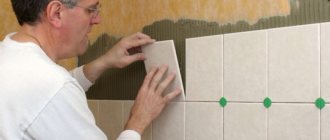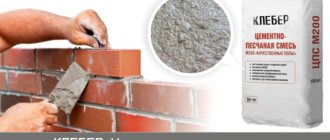The European brand Kleo is one of the leaders in the production of high-quality consumables for decoration and repair. Initially, the products were produced for industrial use. Today the company offers Cleo glue and other installation materials for independent home use. In the article we will consider a line of adhesive mixtures for different types of wallpaper, their characteristics and features.
Tips: how to dilute glue for non-woven wallpaper
For proper breeding, you must first decide on the type of wallpaper, as well as the type of surface on which the wallpaper will be applied.
Glue can be purchased at any hardware store; there is a universal glue on sale that is suitable for most wallpapers, and there are special ones that are intended only for certain types of wallpaper, for example, Quelyd brand glue (Kilit) or Swedtex brand glue, intended only for non-woven fabrics " In order for the wallpaper to be properly glued to the surface, it is necessary to dilute the glue correctly. When diluting glue, the proportions must be strictly observed.
To do this you need to do the following:
- Read the instructions that are printed on each package of glue; usually the instructions describe in detail how best to dilute the glue for different types of wallpaper and different surfaces.
- It is necessary to pour warm water into the container in the volume according to the instructions.
- Glue is poured into the water in a thin stream.
- Then start stirring the mixture.
- After stirring, you need to leave the entire mass of glue to swell exactly as much as written in the instructions.
You can stir the glue with a wooden stick, or best of all, use a stirrer attachment for an electric drill, which allows you to quickly mix the whole mass; you need to stir thoroughly so that there are no lumps. If after a while the glue mass seems too thick, you need to dilute it a little with water. But you shouldn’t overdo it; if the glue is too liquid, you won’t be able to properly stick non-woven wallpaper with it.
This glue can only be used for priming surfaces.
If the instructions are lost, you can dilute the glue at the rate of 5 liters of water per 250 grams. glue, and if non-woven wallpaper is embossed and heavy, then it should be diluted at the rate of 4.5 liters of water per 250 grams. glue.
Applying glue to walls
The mixture is applied to the walls with a roller or brush. It is better to use both of these tools - it is easier to coat large and smooth areas with a roller, and use a brush to grease joints, apply glue to corners, near baseboards.
It is recommended to start gluing 40 cm from one of the corners. At this point, use a plumb line to draw a vertical line - the first strip of wallpaper will be aligned with it.
The glue layer should be uniform. Kleo Extra does not contain a colored pigment, so you need to carefully monitor its uniform application. It is better to draw a dotted line on the wall the width of the roll plus 2 cm. This will avoid dry joints and facilitate the application process.
It is necessary to paste a room indoors, without drafts or open windows. The optimal temperature for this is 10-25ºС. In such conditions, the glue will dry evenly and not too quickly. If wallpaper installation is carried out by a non-professional, the joints need to be brushed - the glue dries quickly in these places.
Instructions for use
The reliability of the wallpaper's adhesion to the surface depends on the correct mixing of the solution from the dry mixture. Before breeding, prepare all the tools so as not to be distracted. We will need:
- High capacity;
- Wooden stick or slat for stirring;
- Cold water.
The mixture can be diluted using a drill with a screw attachment. Kneading is done at low speed.
Correct breeding
The instructions and procedure will be the same for all types of dry solutions:
- Pour water into the container (the amount is indicated on the glue package). The volume of water should not exceed 2/3 of the height of the container.
- Pour in the dry mixture in parts to mix the solution. Stir after each portion of powder. If you mix with a mixer, the dry powder must first get wet otherwise it will scatter throughout the room.
- Stir until the lumps disappear.
- Close the container with a lid and leave the glue to mature for 5–7 minutes.
- After the glue has matured, mix again. You can start applying.
Applying glue
You can spread the glue with a roller, and coat difficult areas (corners, bends) with a brush. Glue is applied over the entire surface of the wall. In this case it works as a primer.
Then the composition is coated with a section of wallpaper. It is better to do this on the floor, having previously covered it with film. The glue is distributed more evenly and quickly with a roller, but if there is none, you can get by with a brush.
For large repairs, construction crews apply glue with special machines. Glue is poured into the device, a roll of wallpaper is placed on the roller, and the glue thickness is selected using the regulator. The machine automatically coats the wallpaper with the solution.
We recommend watching the video:
Material consumption
For each type of Kleo glue, the consumption is indicated on the packaging. The denser the structure of the composition, the greater the consumption. Typically, for medium-heavy wallpaper, 80–150 g is sufficient. for 20 m².
The consumption of the substance is affected by temperature, humidity and method of application. Optimal conditions for working with glue are 18–22˚C temperature and 75% humidity. When distributing the composition with a brush, the consumption increases. Craftsmen recommend taking the mixture with a small reserve so that in case of unforeseen situations you do not have to interrupt the repair.
Stamps
The market is teeming with the number of adhesives available. It would take a long time to list all the manufacturers, but it is worth noting several reputable brands.
The French company Kleo offers a range of types of glue. For example, Kleo Smart is used for gluing vinyl wallpaper, and Kleo Extra for non-woven wallpaper.
Quelyd is also a French manufacturer. He has both ready-made mixtures and powder, which can be stored in airtight packaging for an unlimited time. Compositions with an indicator, with fungicidal components and even docking agents are presented.
This is only a small part of the market, which offers many types of glue.
Varieties
Kleo glue is available in a wide range, with each model designed for a specific type of wallpaper. Products differ in cost, composition of the dry mixture, purpose and duration of preparation. There are fourteen types of glue in total, each of which has special qualities inherent only to it.
Before you start choosing a composition, you need to familiarize yourself with its characteristics and functional features.
- "Kleo Optima". This glue is intended for paper wallpaper. It is reliable in operation, easy to breed, absolutely harmless and odorless. It takes about three minutes to prepare the composition.
- "Kleo Smart" is used for vinyl wallpaper and has a reinforced formula. Cooking time is seven minutes. The composition includes special starch and antifungal additives. A variation of this model, “Smart indicator”, contains phenolphthalein, which has the ability to change color when dried. This allows you to accurately determine the moment when the canvas has completely dried.
- “Kleo Extra” is an especially strong adhesive for wallpaper on a non-woven basis, capable of holding a heavy and voluminous canvas to the wall. It has a transparent texture, so it is absolutely invisible on the front surface of the wallpaper. The glue dries quickly, so you can start painting the non-woven covering a couple of hours after installation.
- “Kleo Ultra” is the most durable adhesive of the entire presented line. It is intended for glass wallpaper, heavy non-woven models and textile fabrics. The dilution time is five minutes.
- "Kleo Kids" is a specially developed adhesive that has a neutral PH composition and is recommended for use in children's rooms. It is absolutely safe for health, odorless and does not contain harmful components.
- “Kleo deluxe” – consists of a primer and adhesive flakes. The primer is made of modified starch and special stabilizing additives, and the adhesive mass is made of methylcellulose, starch and antiseptic additives. The technology for using this brand is different in that before installing the wallpaper it is necessary to prime the wall. This improves its adhesion to the canvas and improves the quality of the work performed.
- "Kleo ultra" is a ready-made composition with a thick consistency, used for any type of heavy wall hangings. Suitable for gluing ceilings. Consists of specialized additives, polyvinyl acetate and an aqueous solution. The product should be applied using a spatula. It is not recommended to use at temperatures below 10 degrees.
- “Kleo Strong” was created to secure joints; it is used in case of detection of installation defects and for fixing unstuck areas. It consists of a polyvinyl acetate component and acrylic, due to which it has high adhesiveness and a thick consistency. The composition is placed in a tube that prevents spreading and provides ease of application. The glue has low heat resistance, so freezing it is prohibited.
- "Kleo border adhesive" consists of inorganic alkalis, PVA and sodium phosphate. When working with it, it is recommended to use rubber gloves and goggles. Suitable for all types of borders, allows you to adjust the location of elements and does not spread.
- “Kleo Photo” is intended for gluing photo wallpapers that have a slippery and smooth surface. Ideally holds the canvas on the wall, does not leave stains on the front surface and dries quickly.
- “Kleo Total 70” is a universal composition suitable for any type of wallpaper, with high adhesive qualities and ease of use. The glue does not leave yellow stains and is suitable for translucent wallpaper.
- “Kleo Nature” is a specialized product designed for gluing bamboo sheets and cork wall coverings.
- “Kleo Line Special” is an adhesive with a reinforced formula, which has a methylcellulose base and guarantees reliable fixation of the canvases. Can be used for any type of wallpaper.
- “Kleo Professional” is a professional product that contains methylcellulose, antiseptic additives and starch. Allows you to perform any type of room pasting and combines the best qualities of other models.
Aids
Joint and border acrylic adhesives are used as gluing aids. The first is useful for correcting errors in the form of gaps between sheets or peeling off the edges of the canvas, but in such cases it can be easily replaced with bustylate, which has the same property of losing color after drying.
Acrylic border tape is intended for gluing decorative border tapes. It allows you to move the canvas freely and easily correct defects in the form of tears or bevels. However, it can be replaced with PVA or any adhesive composition that was used when gluing wallpaper.
Home manufacturing technology
At home, you can prepare glue from 60 g of flour and 1 liter of water. To do this you need:
- pour water into the pan, put it on the stove and wait for it to boil;
- in another container, mix flour and cold water to form a thick consistency;
- add a pinch of starch and boiled water to the resulting mixture, stirring constantly;
- Re-boil the resulting mixture and use after cooling.
The quality of glue prepared independently will differ in quality and adhesion from professional compositions. After preparing the substance, you should check the adhesion strength on small sections of wallpaper. You can use homemade glue on any surface.
How to calculate consumption
Consumption varies for different types of products. The information is written on the packaging. When calculating, it is taken into account that the density of the wallpaper affects consumption. To buy the required amount of product, you need to know the area of the room. Standard packaging of 100-150 grams is suitable for covering 20-35 square meters.
When calculating, it is taken into account that the density of the wallpaper affects consumption.
To get a durable and high-quality result when gluing wallpaper, you need to pay special attention to the choice of materials used. Cleo brand products are diverse, which allows you to get the most reliable fixation of the canvases
The products have quality certificates, which already indicates the manufacturer’s strict approach to the production of products. To get the best result, you should choose the appropriate type of glue.
Semin
Another French company founded in 1838. Its products were introduced to the Russian market in 1996. The company produces products at three factories, one of which is located in Russia.
Wallpaper glue from this manufacturer is represented by a narrower range than that of the above companies; the brand’s product has been highly appreciated by Russian consumers for its excellent quality. It’s a pity that even in Moscow you can’t buy it in all stores. Non-woven wallpaper glue and dry mixture for textile wallpaper from this company are especially popular.
How long to store?
Situations are different. You prepared the glue according to all the rules, but the repair had to be postponed. Or there is excess solution left, and it’s still a long way from wallpapering the next room. There is no single answer to the question of how long to store diluted glue. It all depends on its quality and other factors. But you can insure yourself against using a low-quality product.
Pack the remaining glue on top with plastic wrap or cover with a tight lid. In this form it can be stored for two to five days. After this period, see for yourself whether the glue has an unpleasant odor or whether the consistency has changed. If these signs are present, throw away the glue. If it looks pretty good, try gluing a small piece of wallpaper to any part of the wall and check how it holds up. If after drying everything is fine, proceed with a large volume.
There are also ready-made types of glue sold in liquid form. It is convenient because it does not need to be diluted; ideal proportions are observed during its manufacture. And manufacturers guarantee that it can be stored for at least a year and will not lose its properties and quality.
Preparing the surface
It is necessary to thoroughly prepare the surface of the walls, namely, tear off the old wallpaper from them to perfection and remove the remaining pieces. If there are cracks, they must be plastered and then the walls must be carefully primed.
If the surface is too porous, you will need to apply several coats of primer. You can treat new walls in one or two layers, and old ones - at least two layers.
It is recommended to use only high-quality primer solutions, which will only increase adhesion.
Glue and wallpaper base
The general rule is to buy the type indicated by the manufacturer on the label. The successful outcome of the work depends on the material, weight and texture of the trellises.
For paper wallpapers that are lightweight, mixtures based on CMC, PVA, and even pastes made from flour or starch are used.
Fiberglass wallpaper is a heavy material, so professionals recommend using products from Russian, Decoro, or French brands Kleo and Quelyd. All these compositions have one very important property - they do not dry out instantly, i.e. “give” the opportunity to the worker to adjust the canvas as accurately as possible.
How to properly prepare the adhesive solution?
The dry adhesive mixture is sold packaged in a plastic bag and placed in a standard cardboard box, which contains 250 g of product. Each package contains a detailed description of the sequence and method of diluting the adhesive with water. To obtain a solution of perfect consistency, free of lumps and clots, strict adherence to all instructions is necessary. Only strict adherence to all points can guarantee the consumer the exemplary quality of wall coverings promised by the manufacturer.
The walkthrough consists of five moves:
- To prepare the solution, it is allowed to use only clean containers (a basin or bucket), a clean stick or mixer (for the mixing procedure itself) and clean water (preferably at room temperature or a little warmer).
- The required amount of water indicated on the packaging with glue is poured into the container; most often it is 7-10 liters.
- The mixture is poured into the water in a thin stream near the very edge of the container, while continuously stirring the solution with a stick, a mixer, or simply by hand.
- Infuse the resulting solution for five minutes to ensure uniform penetration of water and the mixture.
- Final thorough control mixing of the resulting solution to achieve the ideal consistency.
The packaging with the adhesive composition states that its contents, after proper preparation of the mixture, should be enough for 35 m² of the area of the wall or ceiling surface to be pasted. But experienced craftsmen who have been professionally engaged in interior decoration for a long time recommend that before diluting the mixture with water, take into account the roughness of the walls prepared for pasting and the weight of the wallpaper to be pasted. By making the solution a little thicker than the instructions require, you can achieve more reliable adhesion between the porous surface of the wall and the smooth surface of the wallpaper.
One of the most beneficial advantages of Kleo glue is its ability to be stored in finished form for 10 days without loss of performance characteristics
This is a very important advantage for those who decide to do repairs, which usually last more than one day, on their own
The adhesive composition of the Kleo brand has proven itself well in the modern finishing materials market. Impeccable quality, a wide range of products offered and affordable prices make it a true favorite among opponents. Grateful and admiring reviews from the happy owners of the updated interior speak for themselves.
To learn how to properly prepare wallpaper glue, watch the following video.
Kleo traditional French quality. Wallpaper glue brand Kleo
Kleo is a French brand of adhesives, including wallpaper adhesives. Kleo brand wallpaper adhesives are famous for their quality, which is very important when gluing not only expensive wallpaper, but also cheaper options.
A simple and concise motto: strong, reliable, easy
Wallpaper glue is packaged in a cardboard box, inside which the dry composition is additionally placed in a plastic bag. This double packaging helps protect the powder from moisture and clumping. In addition, it is easier to dilute the powder with particles of the same fraction, without lumps.
Advantages
The packaging of Cleo brand glue contains detailed instructions for preparing the adhesive composition. In order to dilute glue, you don’t need to go to the Internet and read how it’s done.
All types of Kleo brand wallpaper adhesives are prepared very quickly, the lightest in 3-5 minutes, the strongest in 7-10.
Kleo glue in its finished form is a liquid, homogeneous composition that is easily applied to wallpaper.
Traditional French quality from a famous brand
When applied and after drying, the glue does not leave any streaks or stains on the wallpaper, even if you accidentally managed to get it on the front side of the wallpaper.
As Kleo glue dries, it becomes transparent.
The wallpaper hangs quite loosely on the wall, making it possible to easily adjust its position.
After complete drying, the composition reliably holds the wallpaper together with the wall.
The glue contains antiseptic additives, which allows you not to worry about the possibility of mold or mildew forming on the wallpaper.
Universal professional wallpaper adhesive
The shelf life in dry form is 5 years, in finished form - up to 10 days, which is a lot by today's standards. Usually, the glue can last a couple of days in its finished state.
The cost per pack of Cleo brand glue is consistent with its quality. In addition, it is available in most hardware stores and is not in short supply.
Range
The official website will help you find more detailed information about adhesive compositions, but we will tell you about the main names.
Kleo Optima for paper wallpaper
Cleo Optima is designed for gluing paper wallpaper; it is easy to prepare and reliable. The time for mixing and settling the glue until ready is 3 minutes. It is easy to breed; anyone can do it. Optima brand glue is harmless to people and even animals, which is quite comparable to the properties of paper wallpaper.
The simplest adhesive composition is packaged in a green pack
Kleo Smart for vinyl wallpaper
For gluing vinyl wallpaper, use Kleo Smart wallpaper adhesive. The preparation time for the finished composition of this brand is twice as long as that of Optima and is 7 minutes. This is due to the fact that the formula of the composition is strengthened to hold heavier canvases on the wall. Vinyl wallpaper adhesive is made from special starch with antifungal additives.
Vinyl wallpaper adhesive can be easily identified by its blue pack
Kleo Extra for non-woven wallpaper
Non-woven wallpaper requires the highest quality composition that can hold a large wallpaper on the wall. This composition of the Cleo brand is Extra. The Extra modification was developed taking into account the characteristics of non-woven wallpaper.
Pink pack of glue brand Cleo
The preparation time for the composition is 5 minutes. When finished, Extra glue has a white appearance, but after drying it becomes transparent.
Note: a couple of hours after gluing the non-woven wallpaper onto the wall, it can already be painted.
Kleo Ultra for glass wallpaper and textiles
The Ultra adhesive composition is considered the most durable in the Cleo line of wallpaper adhesives. It is manufactured for gluing heavy non-woven wallpaper, textile wallpaper, and glass wallpaper. The Ultra composition allows you to glue more wallpaper; it is diluted in 5 minutes and is ready for use. Detailed instructions for working with Ultra glue are included on the packaging, which is very convenient.
Excellent adhesive for textile and non-woven wallpapers
Kleo Kids for children's rooms
For wallpapering in children's rooms, the Cleo brand has developed a special PH neutral composition that does not have any effect on children. This is an environmentally friendly and safe formula that is harmless to both people and pets.
However, in dry form, the glue must be kept away from children.
Stocking up on tools
Preparing glue is a simple operation that does not require any special skills or abilities. But to get quality products, you should stock up on some auxiliary tools:
- A container of a certain volume. To cover one room, a regular bucket or basin will do. At the same time, you can always quickly prepare more mixture if it runs out. This became possible due to the fact that all solutions are instant and are prepared in about 5-10 minutes, depending on the manufacturer and brand.
- Mixing device. The simplest option would be a wooden stick. If the amount of mixture is significant, then you can use a construction mixer or a drill with a special attachment.
Please note that all tools must be clean
This is important, since the ingress of dirt can have a bad effect on the quality of the wallpaper. Therefore, try to check if there is any sand or dirt left in the bucket or on the mixer
Therefore, try to check if there is any sand or dirt left in the bucket or on the mixer.
Breeding procedure
Kleo has a soft texture, dissolves well and is transparent, thanks to which the dried glue does not turn yellow and does not spoil the appearance. The procedure for diluting and applying wallpaper glue is as follows:
- according to the instructions, the dry mixture is diluted in the required proportions with water (each type of glue has its own instructions), first water is poured into a bucket or other container, then the adhesive is poured into it and mixed thoroughly;
- the prepared mixture should be left for 5 minutes and then stirred again, you should get a transparent, homogeneous mass of a transparent color;
- then glue is evenly applied to the pre-cut wallpaper using a large paint brush or a large soft roller. Experienced specialists prefer rollers; thanks to them, the application procedure is much faster and more uniform;
- after the wallpaper has been saturated or the glue has been applied to the wall, you can begin gluing;
- After the canvas is fixed in the desired position, it is carefully smoothed with a cloth, a rubber roller, or a spatula, and any remaining glue is removed.
Let's analyze the most likely glue consumption (in relation to vinyl wallpaper):
1. When the surface requires preliminary priming, the mixture (dry) is diluted with heated water in a ratio of 1:40. This proportion is obtained by dissolving a standard pack (300.0 g) of the substance in a container with 12.0 liters of water. The resulting amount of glue is enough for a full primer of approximately 100.0 square meters. m of concrete-brick walls.
2. To apply structural, textile or vinyl wallpaper, a fairly thick adhesive mass is required. Dry fixative powder (300.0 g) must be thoroughly diluted with heated water (6.0 l) - proportion 1:20. The prepared amount of mixture will be sufficient to thoroughly process approximately 36.5–40.3 square meters. m.
3. Thin, light wallpaper can be glued with a less dense glue. You can dilute a 300.0 gram package with 9.0 liters of water in a ratio of 1:30. The resulting volume, if applied correctly, will cover 45.5–50.3 square meters. m of working surface.
What cyanoacrylate glue glues: scope of application
Most of the superglue is cyanoacrylate and its derivatives, and it is also supplemented with various additives - plasticizers. It is thanks to them that several main areas of use of such glue can be identified. Let's look at what cyanoacrylate-based super glue glues.
For gluing rubber and leather products, it is better to use two-component adhesives.
First of all, you cannot do without cyanoacrylate compounds in everyday life. Almost every owner has this glue in their repair kit. Various compositions are used depending on the situation and the material to be glued, although universal adhesives are often purchased for the home.
Not only men use cyanoacrylate glue. It is used in cosmetology, namely during eyelash and nail extensions. Usually they use compositions with an increased amount of acrylic, since they practically do not harm the nails, and are also easily and simply removed using organic solvents.
Cyanoacrylate superglue is indispensable in dentistry. Special compounds are used for gluing small chips. Adhesive is used to create insulation on wires or to ensure a perfect connection. The low likelihood of allergies and biological neutrality make the substance a safe product for use in cosmetology and dentistry.
In everyday life, cyanoacrylate glue is used for gluing almost any surface.
Cyanoacrylate is used with pleasure by radio installers and repairmen of electronic equipment and optical devices.
Using this glue you can perform the following procedures:
- glue chips and boards;
- produce thermal resistors and transistors;
- create prefabricated structures from plastic and thermoplastic;
- combine natural fabrics, organic and artificial leather;
- glue foam particles;
- connect surfaces for which permanent color is extremely important.
Types of glue by type of base
Depending on the type of base on which the wallpaper is applied, the appropriate type of glue is selected. Using the correct adhesive to treat the base will ensure that the wallpaper adheres securely and evenly. The difference between all types of glue lies in the composition, consistency and method of application.
Paper
The most common option for wall decoration is covering paper wallpaper with PVA glue. The substance is produced as a white mixture. Before use, you only need to dilute the mixture to the required consistency in accordance with the attached instructions. Apply paper glue to the back side of the material. If the product gets on the front of the canvas, wipe it off with a slightly moistened sponge.
Non-woven
When purchasing non-woven glue, it is important to correctly calculate the consumption of the substance in order to avoid unnecessary costs. This glue can be used for paper and two-layer non-woven coverings, but in the first case the consumption will be 2 times higher
To finish a standard room, you will need to dilute about 200 g of the substance in 5 liters of liquid.
Non-woven adhesive differs from paper adhesive in its improved quality indicator, since starch ester is used as a raw material base for its production. The component enhances the consistency of the mixture, adds viscosity, and affects the properties of fluidity and moisture retention. The amount of starch added to the adhesive depends on the specific manufacturer and is adjusted to obtain optimal structural viscosity. The starch esters contained in the composition are completely compatible with other substances, since they are chemically inert.
Universal
It is advisable to purchase a universal type of glue when decorating a room with several types of coatings. The product is suitable for rolls of any size and density. Strong fixation on the walls is achieved by adding synthetic resins and various chemical impurities to the composition. The ability to use with any material is the main advantage of universal adhesive. The disadvantages of this substance include:
- higher cost compared to glue for a certain type of base;
- the presence of harmful components in the composition.
Specialized
A specialized type of glue is a dispersion solution with improved characteristics. The product is often used for fiberglass and fabric wallpaper. The adhesive has a strong hold, so if it is necessary to dismantle the coating, you will need to use solvents.
Specialized adhesive with an indicator is also widely used in the construction market. With the help of coloring components, the solution acquires a pinkish tint, thanks to which you can easily control the uniformity of application to the surface of the base or canvas. This dye does not leave stains and does not penetrate the front side of the wallpaper, since it is neutralized during drying.
Material characteristics
It’s not for nothing that Cleo wallpaper glue is so in demand on the building materials market. Its special characteristics determine the choice of many professionals and beginners in favor of it. The following characteristics are distinguished:
- Moderate cost;
- Lump-free and smooth application;
- Quick readiness, in 5 minutes;
- Excellent sliding properties, moving the canvas will not be difficult;
- Ease of further dismantling work;
- Transparency;
- You can paint the walls after gluing in two hours;
- Neutral pH level, which allows the composition not to cause allergic reactions in people.
Special characteristics determine the choice of many professionals and beginners in favor of it.
Basic principles for diluting wallpaper glue
Let's take a step-by-step look at how to dilute wallpaper glue. You need to follow the following instructions.
- Pour water into the prepared basin or bucket. The main thing here is to know what water to dilute the composition with. This is usually indicated by the manufacturer on the packaging. For a high-quality mixture, a liquid from 25 to 40 degrees is suitable.
- Referring to the instructions on the pack, find out what proportions the ratio should be. First, pour water, and then add the required amount of dry additive. If you overdo it, it's okay, but if you use too little, the consistency will be very sparse. It is not suitable for vinyl and non-woven wallpaper, as they are heavy.
- Before pouring the powder, use a stick to create a funnel of water. Pour everything in slowly and stir the substance. This way you can dilute the liquid without lumps.
- After the solution is ready, it should be stirred for another 10 minutes. After this, leave the container with the liquid to infuse. It takes 20 minutes for the liquid to release the desired properties and swell. If you need to hang heavy wallpaper, it is better to leave the substance for at least an hour.
- There are no restrictions on the tool you will use to stir the glue. The main thing is to do it right. The consistency is mixed very thoroughly and for a long time until completely cooked. You can tell that everything is ready when the consistency becomes uniform and transparent.
Before you start gluing wallpaper, we recommend that you familiarize yourself with a few tips. They will help you carry out high-quality repairs regardless of the size and type of room
Please note that:
For thick and heavy wallpaper, a thick consistency will be required. It will hold the material on the surface and prevent it from peeling off. Before mixing glue, you need to take into account the proportions. Therefore, divide the packaging into two parts. You can add powder if the resulting composition does not have the desired density. There is no need to dilute the prepared consistency by adding dry powder. It is better to mix a new solution
Otherwise, the appearance of lumps cannot be avoided. It is important to maintain proportions even if you need to prime the walls before gluing. Here the glue should be thicker than that used for wallpaper. Carefully read the instructions not only on the glue package, but also on the wallpaper.
The first will indicate how to properly prepare the composition, and the second will tell you which glue is suitable for a particular type.
The success of finishing work depends on how correctly the mixture is prepared. In case of mistakes, lumps from lumps will be visible on the walls, and the joints will peel off almost instantly.
Preparing the glue mixture
In order for non-woven wallpaper to cling tightly to the wall, it is necessary to strictly adhere to the proportional ratio of water to powder. Usually for household use they take a pack weighing 250 grams.
For it you will need exactly seven liters of water (necessarily at room temperature, and under no circumstances boiling water!
Otherwise, you will simply ruin the glue). Stages of manipulation: open the bag, pour water into the container, and gradually pour powder into it along its edges.
Next, slowly stir the mixture until the lumps are completely dissolved and set aside for five minutes to infuse. Then mix again and apply calmly.
Typically, the powder can dissolve quickly without using a mixer, and lumps and flakes will disappear in a matter of seconds.
This device can be used to speed up work. The consistency of the mass will be slightly cloudy and white. Don’t worry, because after drying the adhesive mixture will become transparent and invisible.”
Usually professionals prepare the mixture despite the instructions - they dilute the powder taking into account the condition of the walls and canvas.
If the wallpaper is thick and embossed, and the walls are a little rough, then you need the glue to be thicker (this will hide all the imperfections and increase the fixation of the material).
But do not overdo it with the thickness, because the higher it is, the more difficult it will be to apply and rub the glue.
Therefore, it is best for a beginner to navigate and strictly follow the instructions, and if there are any difficulties on the walls, it is advisable to seek the help of specialists.
What kind of work can it be used for?
Before using polymer glue, you need to familiarize yourself with what kind of work it is best used for.
Installation of parquet boards
Polymer-based adhesives are used during the installation of parquet boards, which are often laid on the surface of concrete screeds. When installing parquet, the adhesive must be applied at an air temperature of about 20-25 degrees Celsius. In this case, the air humidity should be at least sixty percent. Only under such conditions will the boards be securely fixed on the concrete surface.
Cladding of various surfaces
Often, facing work is carried out on the outside of the house, during which polymer glue is used. With its help, decorative stones, plasterboard panels, tiles, wood boards and even metal cladding sheets can be fixed to the surface of the walls. To work with such materials, it is better to use universal mixtures.
Fastening plasterboard sheets
Some people believe that plasterboard panels need to be attached only to a metal frame, but this is not the case. Sometimes it is better to install them directly on the wall surface, without using an additional frame. In this case, a universal polymer adhesive is used to secure the sheets.
Minor repairs to furniture and household items
Often people experience minor damage to household items or furniture. Sometimes it is impossible to repair them, but there are times when it is enough to glue the broken item. To repair furniture and household items, you need to use adhesive solutions intended for interior work.
Creating and securing decorative elements
Polymer adhesive mixtures are often used to attach façade decorative elements. To attach decorative elements, universal-type compounds are used, which are resistant to high air humidity and temperature changes.
The best way to seal the seam of a fishing overalls, choice of compositions and instructions
Attaching the ceiling covering
When carrying out renovation work indoors, some people are engaged in gluing the ceiling covering. For this purpose, special plates are often used, which are attached to the surface with solutions containing polymer components.
Roofing
When constructing houses, the final stage is the installation of the roof, during which roofing work is carried out. Polymer adhesive is used in the process of laying roofing on the surface of the supporting structure.
Glue stick
The most common and accessible is pencil-shaped glue. It is very convenient to use thanks to the compact bottle, which is comfortable to hold with your hand. It has a dense consistency, so it is used sparingly. Successfully glues paper and cardboard, as well as textile materials.
It is applied simply and evenly and does not stain your hands. When working with it, no additional applicators are needed. Suitable for gluing small or irregularly shaped parts, since only the required amount of glue is applied in an even layer. Under the closed cap it does not dry out for a long time, when processed with it the surface is not deformed, and after drying there are no traces left. It is perhaps the most suitable type of glue for children's creativity.
The only drawback of the glue stick is its weak gluing ability. He won’t be able to handle a material more complex than thin cardboard.
Available in packages of different sizes. Choose a comfortable pencil that matches the size of the child's hand.
These compounds thoroughly glue both paper and thick cardboard. They are also suitable for creating appliqués from fabric, threads, feathers, and natural materials. Liquid PVA is ideal for those who use fragile raw materials (for example, dry leaves) in their creativity: it will create a neat but strong gluing. The composition does not deform the paper and does not leave yellow spots. It is easy to apply and distribute.
The glue, in general, is applied in an even layer on both surfaces, which are then pressed firmly against each other. The setting time is a few seconds, and complete drying is achieved within a day. PVA glue for paper and cardboard is harmless, does not have a pungent odor, is colorless when dry, can be easily removed from any substrate, and can be easily washed off your hands.
We work correctly with self-adhesive film
Self-adhesive film constantly helps us out: this material is used to cover kitchens, bathrooms, doors, household appliances, and old furniture. The film is easy to use, safe for humans and is not afraid of high temperatures. It seems that covering surfaces with film is a matter of minutes and is simple. There are, however, a few tips that can help anyone who wants to renovate an apartment with their own hands. To work, you will need any self-adhesive film in rolls, a knife or scissors, a hair dryer, varnish, primer and wallpaper glue, a ruler and dishwashing detergent. First you need to prepare the surface that needs to be covered with film. The first one should be smooth, clean, free of grease or dust. Any detergent can be used for degreasing. If this method is powerless against stains, an alkaline solution comes to the rescue. If you need to cover a rusted steel pipe, to do this you need to remove all roughness with sandpaper and it is advisable to degrease the steel pipe. You can degrease it with a solvent. Plastic, glass or metal is slightly moistened with water before pasting. A few drops of detergent are added to the water. If the film will be glued to porous, rough surfaces (plaster, plywood, wood, fabric, ceramic tiles or cork), then the latter must be dry.
In order for the film to stick as firmly as possible, the wooden surface should be primed using primer or polyester varnish. Methyl wallpaper glue will also come in handy. Cracked or uneven surfaces are leveled with putty, sanded and coated with acrylic primer. Next you need to cut the film. A centimeter scale (grid) on the back of the self-adhesive film will help in this matter. In order to cut even pieces, you should use a ruler and a knife. In this case, you should leave a margin of 2-3 cm. In the case when the film pattern is with repeat, the films are cut from the front side.
Let's start gluing the surface. The paper is separated from the self-adhesive film by approximately 5 cm and the free edge begins to be glued. Then, with one hand, the paper is gently pulled back, and with the other, it is smoothed over the surface from the center to the edges with a soft towel. If it was not possible to avoid the formation of bubbles, then they are carefully pierced with a thin needle. To paste the edges and corners, use a hairdryer to heat the edges of the film and bend them. In the case when it is necessary to paste over a large surface, the film is cut into large panels with an allowance of 1.5 cm. It should be taken into account that the surface to be pasted must absorb moisture well. The surface is covered with wallpaper glue and panels are applied until the glue dries. The film is pressed with a sponge or rag and smoothed out. In the case when the film sticks very quickly, sprinkle the surface with talcum powder or powder - this will help slow down the gluing process, as well as easily move the film in the desired direction. If it is necessary to cover edges or corners with film, small objects (for example, books or a stool), protruding corners of the self-adhesive material are cut at an angle of 45 degrees, and then folded and glued. This work is quite simple, but it requires perseverance and patience, especially when working with large surfaces. Ideally, they should turn out even and smooth. Delivery of new homemade products to the post office
Receive a selection of new homemade products by email. No spam, only useful ideas!
*By filling out the form you agree to the processing of personal data
Top five
The cheapest adhesive for non-woven wallpaper is “Moment” with the corresponding mark. The brand belongs to a German manufacturer, and this alone already speaks of the high quality of the product. The cheapness is explained by the fact that the product has been produced in Russia for quite a long time.
The composition of the glue allows for excellent adhesion of the trellises to the wall. Craftsmen get especially good results when working with the smooth texture of wallpaper.
The advantages include:
- stored in a diluted state for several days;
- available in almost any store that sells repair products;
- despite the name, it does not dry instantly, but this allows you to align the joints.
Another product from the German company Henkel, Metylan glue, can also be classified as a budget option.
When purchasing, you must carefully read the note on the box to determine what type of non-woven wallpaper the product being sold is suitable for. Not all mixtures have a color indicator that allows you to determine the gap between the wallpaper sheets.
Following the “Germans” were two “French” - “Kleo” and “Quelyd”. The first leaves no traces and contains a special antifungal additive. Well, “Quelyd” is considered the best glue for non-woven wallpaper.
"Exclusive Non-Woven" is an expensive glue that cannot be found in every store. Experts recommend using it when working with heavy trellises, silk-screen printing and vinyl.
Secrets of pasting
Due to the unique composition and texture of non-woven wallpaper, glue plays a major role in a good and durable gluing result. A good and professional glue should have the following qualities:
- lie evenly on the wall;
- have the appropriate density after dilution, suitable for the density of non-woven wallpaper;
- form joints well and provide the opportunity to correct the position of the canvas if a mistake was made;
- should not contain coloring substances.
These are the qualities that Kleo adhesive for non-woven wallpaper has.
Stocking up on tools
Preparing glue is a simple operation that does not require any special skills or abilities. But to get quality products, you should stock up on some auxiliary tools:
- A container of a certain volume. To cover one room, a regular bucket or basin will do. At the same time, you can always quickly prepare more mixture if it runs out. This became possible due to the fact that all solutions are instant and are prepared in about 5-10 minutes, depending on the manufacturer and brand.
- Mixing device. The simplest option would be a wooden stick. If the amount of mixture is significant, then you can use a construction mixer or a drill with a special attachment.
Please note that all tools must be clean
This is important, since the ingress of dirt can have a bad effect on the quality of the wallpaper. Therefore, try to check if there is any sand or dirt left in the bucket or on the mixer
Therefore, try to check if there is any sand or dirt left in the bucket or on the mixer.
Special types of glue
There is a special line of Kleo products on sale. Among the special types of glue of this brand are those used for borders, joints and some other materials.
Joint adhesive Kleo Strong
The strengthened formula of the glue allows it to be used for gluing joints of wallpaper and other types of decorative coatings. This product can be used to remove blemishes and defects and re-glue peeling wallpaper. Polyvinyl acetate and acrylic components have been added to the composition, which improve adhesion. It is not sold in dry form - it is packaged in small tubes, which are very convenient to use. The glue is thick, after application it does not crack or peel off.
Border adhesive
The material contains a number of inorganic alkalis, as well as sodium phosphate. This allows wallpaper borders to be firmly glued. When working with glue, you need to wear goggles and gloves; if it gets on your skin, you must immediately rinse it. The material is packaged in tubes, it is convenient to use, and due to its thickness it does not flow along the wall.
Kleo DeLuxe with primer
The material, unlike others, is sold in two-component form. The first bag is filled with dry glue itself, the second with primer. The powder contains starch and antiseptic additives, as well as methylcellulose. The soil is represented by starch and a number of targeted additives. The use of glue is suitable for the following materials:
- vinyl;
- cork;
- jute;
- reed;
- bamboo;
- fabric;
- velor;
- fibrous;
- metallized;
- heavy paper;
- wallpaper-paintings, frescoes.
The glue is especially strong and can hold even the heaviest wallpaper. The composition contains special components that reliably attach materials at joints and problem areas. The special starch of this glue completely eliminates damage and deformation of the canvas, and also provides high initial adhesion. A package of 350 g of powder and 80 g of primer is enough for gluing 35-40 square meters. m wallpaper. The primer is used for the initial treatment of walls before gluing the canvas.
Kleo ULTRA ready
The finished glue does not need to be diluted - it is simply applied to the walls with a roller, brush, or machines. The glue is sold in 5 and 10 kg cans and looks like a thick white paste. Scope of application - for any type of wallpaper, can be used to decorate walls and ceilings.
The ready-made glue is even suitable for gluing glass wallpaper, cork, and any other heavy fabrics. The composition includes polyvinyl acetate, targeted additives, water, without solvents. Complete drying time can take up to a day; the product can be used at temperatures above +10 degrees. Consumption – up to 250-330 g/sq.m. m walls.
Kleo Ultra
Kleo Ultra glue is especially popular among builders. Its unique composition is ideal for almost any type of wallpaper. Unlike specialized varieties that are suitable only for one type, Cleo Ultra easily copes with non-woven, vinyl and glass wallpaper.
Its advantages include the following qualities:
- high quality;
- strong and stable composition;
- economical use;
- thick consistency;
- fast absorption;
- high drying speed;
- transparency after dilution, which guarantees aesthetics and respect for the wallpaper;
- environmentally friendly composition;
- no unpleasant odor;
- possibility of easy adjustments before the glue dries.
